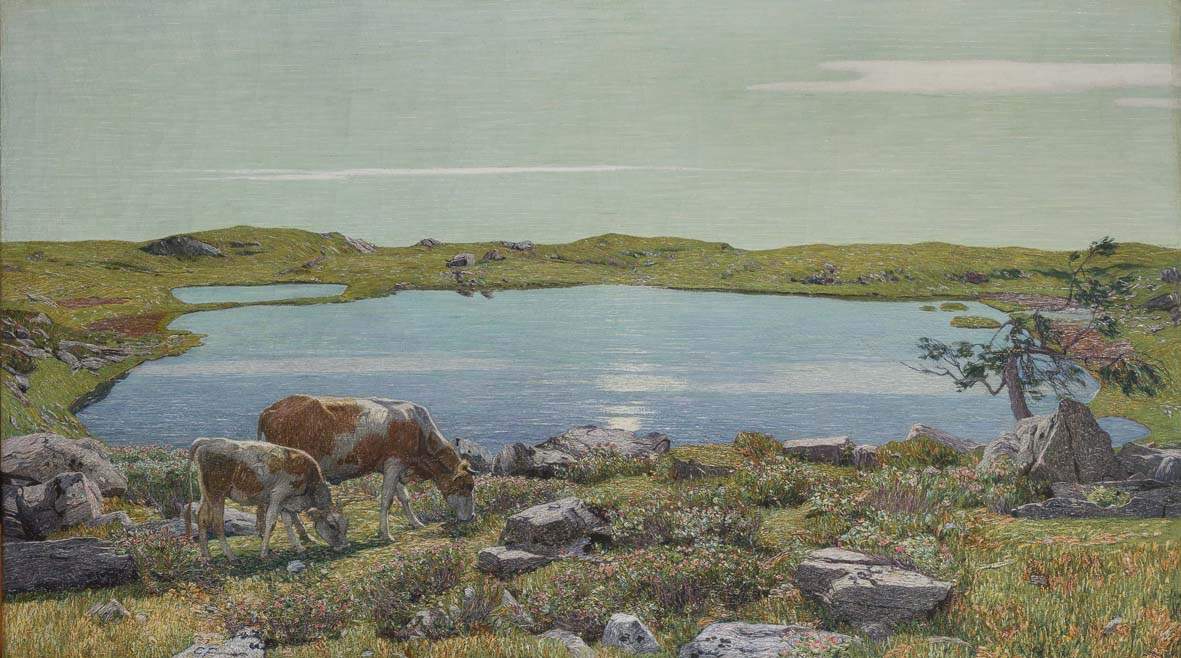From May 25 to October 20, 2019, Casa De Rodis in Domodossola (province of Verbano-Cusio-Ossola) is hosting the exhibition Carlo Fornara. At the Roots of Divisionism 1890-1910, entirely dedicated to one of the most important Divisionist artists, Carlo Fornara (Prestinone, 1871 - 1968). The exhibition, curated by Annie-Paule Quinsac, is proposed by the Poscio Collection focuses directly on the two decades between 1880 and 1910, the years of greatest creativity and innovative capacity of the master, whose 50th anniversary of his death was celebrated in 2018. The exhibition features an important selection of canvases (some of which are the objects of restoration work carried out precisely in function of their display in this exhibition), flanked by a section devoted to the master’s drawings.
The 1890s were a formative season for Carlo Fornara under the guidance of master Enrico Cavalli, spiritual heir of the Marseille-born Adolphe Monticelli. “Years also of personal affirmation, when, having made Monticelli’s impasti his own, Fornara elaborated a luminist language of textural spatula painting and enamel-effect brushstrokes,” says curator Annie-Paule Quinsac. "This ’first manner’ would be destined to change due to the shocking encounter/confrontation with the symbolism of Giovanni Segantini, to whom he went as an assistant in August 1898 at Maloja in the Engadine and whose unpredictable disappearance at the height of his glory (the following year, in September 1899 on the Schafberg) shook him to the core, marking his soul and his proceeding as a young adept."
In the first decade of the new century Fornara proposed a painting of European and international outcomes with works, many of which are offered in the exhibition(Chiara pace, L’aquilone, Fontanalba, Ombre e luci), characterized by Divisionist experimentation. An experimentation that, gradually overcoming the influence of Segantini’s themes and vision, arrives at an entirely original way of transposing into canvases the beauty of the Vigezzo Valley, where the artist was born in 1871, “restored in the dual nature of poetry and strength together,” the curator points out.
Born in Prestinone in 1871 into a humble peasant family in the Vigezzo Valley, Fornara, thanks to his precocious talent, had access to courses in painting, drawing and ornamentation at the local Rossetti Valentini art school in Santa Maria Maggiore. There he forged friendships with other future painters such as Giovanni Battista Ciolina, Gian Maria Rastellini and Lorenzo Peretti iunior, all students of Enrico Cavalli, a great connoisseur of French art at the time. In the spring of 1891 Fornara exhibited at the First Brera Triennale, an opportunity to come into contact with the new Divisionist instances. Between 1894 and 1895, in Lyon, Fornara approached the pictorial current of Neo-Impressionism, which manifested itself in the work En plen air, rejected in 1897 by the Third Brera Biennial, but appreciated by Giuseppe Pellizza da Volpedo and Giovanni Segantini, two of the major exponents of the Divisionist current. His participation in the third International Art Exhibition in Venice was in 1899.
Having come into contact with Alberto Grubicy de Dragon, owner of the Grubicy Gallery and brother of the promoter of pointillism at the European level, the art dealer and painter himself Vittore Grubicy de Dragon, Fornara was greatly appreciated by both and put in contact with Segantini, who wanted the young artist as his assistant, for the 1900 Paris Exhibition. Thanks to the patronage of the Grubicy family, Fornara was present at the major national and international painting exhibitions of those years.Gradually, his adherence to the Divisionist school began to weaken around the 1920s, when the artist began his own pictorial research with a wholly personal style. Beginning in 1922, he chose his beloved Vigezzo Valley, where he continued to paint until his death in 1968.
The exhibition opens on Saturdays and Sundays from 10 a.m. to 1 p.m. and 3 p.m. to 7 p.m., and in July and August also from Tuesday to Friday from 3 p.m. to 7 p.m. Tickets cost 5 euros, and children and young people up to 18 years old get in free. The exhibition is accompanied by a catalog published by Silvana Editoriale. For more information you can visit the Poscio Collection website.
Pictured: Carlo Fornara, Fontanalba
 |
| In Domodossola an exhibition dedicated to Carlo Fornara, important pointillist artist |
Warning: the translation into English of the original Italian article was created using automatic tools. We undertake to review all articles, but we do not guarantee the total absence of inaccuracies in the translation due to the program. You can find the original by clicking on the ITA button. If you find any mistake,please contact us.